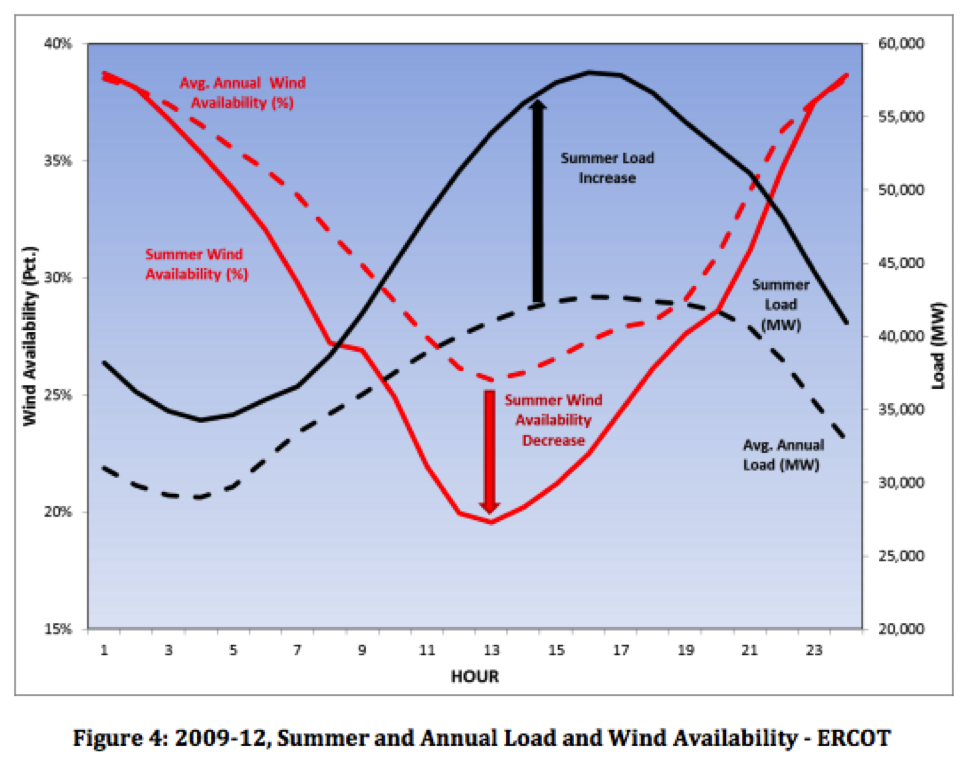Despite the claims of the wind industry, wind power is inherently unreliable because no one can control the wind. It also consistently underperforms reliable electricity sources in terms of capacity factor. That is, wind installations only produce energy at about 34 percent of their capacity, according to the Energy Information Administration. Compare that to the 85 to 90 percent capacity factors for natural gas, coal, and nuclear generators.
Wind supporters concede that short-term variability in wind output is a significant problem. Not only is it hard to predict when the wind will show up, but wind also tends to produce less when the grid needs it the most. When the Electric Reliability Council of Texas (ERCOT) plans its future grid reliability, it only counts on wind to deliver 8.7 percent of its capacity at times of peak demand.
The following graph from a study on the intermittency of wind power shows the lack of availability of wind during summer peak demand.
To highlight the absurdity of providing multi-billion-dollar subsidies to an energy technology that works only when the wind blows and not when people need power, the Institute for Energy Research asks the basic question: What if all energy in your life were as unreliable as wind power? Let’s walk through a wind-powered day and find out.
7:00 am
You wake up to the sound of your alarm clock. Good thing it has back-up batteries that are cost-effective, unlike the wind-powered electrical grid. Wind power has come and gone since you went to sleep, hitting its peak around 1:00 am, but you didn’t really notice because you weren’t using much power. Now that you’re up, you really wish the lights would stay on, but they’re dimming as the wind dies down. The rising sun helps you see your way to the living room. During the last few minutes of good power, you set your DVR to record your favorite show in the evening.
7:15 am
You start brewing your morning coffee, hoping the wind power will stick around a little longer, but the wind dies down further and you’re stuck with half a cup of coffee. Still in a fog from the weak coffee and the low lights, you step into a shower. With some overnight winds, the water heater ran strong around 1:00 to 2:00 am providing you with a nice, warm, start to a shower. After a minute, without additional electricity from wind power to heat more water, the water turns cold. You are left to finish with an “invigorating” cold shower. You step out of the shower a little chilly but determined to make it to work.
8:00 am
Months ago, when you determined to live a “wind’ lifestyle, you sold your gasoline-powered car and bought an electric car. When you get in your car to go to work, you see you only have enough electricity in the batteries for 10 miles of your 15 mile trip to work. It looks like you’ll have to walk and hopefully your car will be recharged by tomorrow.
11:00 am
You finally make it to work on foot but your power and internet connection come and go with the faint afternoon wind. That project your boss wanted done today will have to wait. You can’t even waste time looking at cute animal videos before the wind stops blowing.
6:30 pm
You get home after a long day of waiting to work and the house is sweltering. The wind didn’t blow in the afternoon enough to run the air conditioning. This is pretty typical, but today it’s pretty frustrating.
You want to watch that episode you recorded this morning, but the TV doesn’t come on. When it finally does, you notice that the recording cut off halfway through as the wind died down during the afternoon–right around the same time you were trying to watch kitten videos at work. Frustrated, you decide to just go to bed as the sun sets.
8:00 pm
You try to read a book in bed, but the lights go out as soon as you open it up. You’ll have to wait until the wind starts blowing again, probably around 9 or 10 pm. Even then, you’re not sure how long it will last. So you go to sleep, hoping for better luck tomorrow.
11:45 pm
The wind finally picks up, brightening your bedside lamp and turning on the air conditioning. Oh the joy of modern conveniences! You stay up a couple hours enjoying the electricity from the wind as you read your book in the comfort of a climate-controlled room. It’s not ideal, but with wind essentially only working 1/3 of the time, it’s all you’ve got.
Conclusion
Fortunately, Americans do not have to depend on unreliable wind energy. North America has enough coal for 500 years at current usage levels and over 100 years of natural gas according to IER’s North American Energy Inventory. It should be noted that the United States has by far the largest coal resources in the world.
America’s energy landscape has changed dramatically since Congress passed the wind Production Tax Credit (PTC) in 1992. Between 1992 and 2006, U.S. natural gas production remained essentially stagnant, increasing by less than 6 percent over that period. Thanks to technological advances that combine hydraulic fracturing and horizontal drilling, domestic natural gas production grew by more than 20 percent between 2007 and 2012. Later this year America will be the largest combined oil and natural gas producer in the world, eclipsing Russia.
With such energy abundance, it makes little sense for taxpayers to prop up energy sources that are unreliable and unneeded. The wind industry claims that wind energy is cost competitive, so let wind compete in a competitive market with natural gas, coal, and other energy sources. Consumers, not tax auditors at the IRS, should choose the energy sources that work best for us.
IER Policy Associates Travis Fisher and Alex Fitzsimmons co-authored this post.
